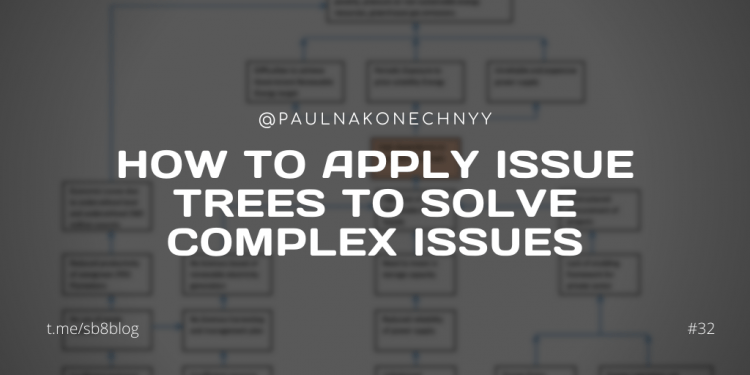How to apply Issue Trees to solve complex issues
Published by Pavel Nakonechnyy on (updated: ) in Business Analysis.
focuses on the broad aspects of your problem (the categories). It allows you to both investigate the root causes of specific events and propose solutions to problems. With Issue Trees, you can divide work on a project between analysts, set up Business KPIs, or initiate a new Product.
Issue Trees are excellent for prioritization. Issue Trees help you create a “route” on how to solve the problem and the ability to anticipate a lot of stuff that could happen along that route.
Issue Trees can be used in every facet of your job:
-
As a map to solve a specific problem;
-
As a guide to brainstorming solutions;
-
As a way to structure a presentation;
-
As a guide to research best practices;
-
As a way to generate KPIs and indicators.
You can have “problem trees” and “solution trees”. With problem trees, you have a problem and you want to know why it’s happening. Then you create a tree with all categories of hypotheses of why it happened. Developing a solution tree, you propose solutions to a certain problem.
Issue Trees are better than free Brainstorming for a number of reasons:
-
Your ideas are gonna be way more organized. This helps you communicate your ideas with others.
-
Creativity from constraints. There’s research showing that having some constraints make people more creative, not less. ()
-
They force you to see whole categories of ideas you wouldn’t have seen before. This takes a bit of practice, but once you’re able to see how each category fits the whole, you might see parts of the whole that you weren’t even seeing before.
One really powerful thing you can do is to use “Problem Trees” to find the problem and once you found it, use a “Solution Tree” on your newfound problem.
There is a number of Principles for creating Issues Trees:
-
Separate different problems early on.
-
Build each part one at a time.
-
Each part must be MECE. ME = Mutually Exclusive = No overlaps between the parts of your structure = your structure is as clear as the blue sky for another person to understand. CE = Collectively Exhaustive = No gaps
-
Each part must be relevant and add insight into the problem. There are many MECE ways to break down any problem. Choose the one that’s more relevant. The one that adds more insight to the problem.
-
Each part must be eliminative and help you focus on the problem.
-
The key to being eliminative is to make each bucket falsifiable. Falsifiable means you can find a test that, given a certain result, guarantees that the problem is not on that bucket. This falsifiability is what makes Issue Trees “hypothesis testing” structures.
-
Clarify what you need in each layer you build. Stop each branch where it reasonably explains the problem. You can go deeper where you need.
What are the ways to decompose your issue into MESE sub-issues?
-
Create Math trees based on known equations.
-
Create a structure based on steps in a process.
-
Create a structure based on a conceptual framework.
-
Perform segmentation into several groups (e.g. customers by age)
-
Use opposites (breaks in supply or loss of demand)
Overall, Issue Tree is a visualization technique for a mode of thinking most entrepreneurs and successful managers apply daily. You may well encounter tasks for Issue Trees on an interview at McKinsey or other consulting firms. With experience, you’ll apply Issue Trees to decompose every complex problem you see subconsciously to present information in a structured way on the go.
This article takes most of its material from of a great long form article made by Crafting Cases.